|
1.
CENTRAL/ WEST AFRICA
Prices stable as Asian traders buy lower log grades
The log market remained largely stable in late February, though there were some price adjustments for the Asian
market, both upwards (e.g. belli logs) and downwards (e.g.sapele, padouk and sipo
logs). Some of these changes may be due to the marginally less stringent grade
standards required for exports to China and India. It is notable that prices for sapele, padouk and sipo did not
decline for European destinations. The upward adjustment in some log prices is mainly due to the
willingness of buyers from China and India to buy lower B and BC/C grades that are not normally purchased by European
buyers. Prices for limba (frake) have been removed from the list as this species has largely fallen out of
favour. Only sporadic small volumes are shipped to Germany. Prices for okoume logs, mixed quality (60% CI, 40% CR
and 20% CS), have been included in the price list.
Heavy rains continue to hamper log supply
Log demand remains very firm in general while supply continues to be constrained by heavy rains in North Congo
and Central African Republic. The rains are affecting the supply of both logs and
lumber reaching the ports. In Republic of Congo, at least one major producer is reported
to be concentrating more heavily on the production of FSC certified timber products for the European
market. The supply of these products is expected to increase in coming months, with current offers not yet at a premium price.
Meanwhile, unconfirmed reports from Gabon indicate that the new log quota system is not yet fully implemented.
Sawnwood prices to remain firm through spring
Sawn lumber prices have held very firm through February. Demand remains strong as mills are busy with current
contracts and steady business from European and Far East regular buyers. Ayous FAS GMS improved by around .30
per m3, while douka/makore FAS GMS moved up strongly from .458 in January to .525 per m3 fob while fixed sizes
and scants increased from .519 to .540 per m3. Okume standard and better grade for Italian buyers, in turn, surged
to .300 per m3 fob. Prices for other species held firm and unchanged, a market situation that appears likely to be
maintained at least through the end of the first quarter and onwards into the usual European spring buying period in
the second quarter.
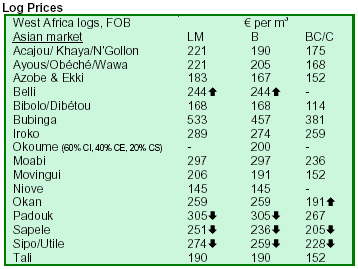
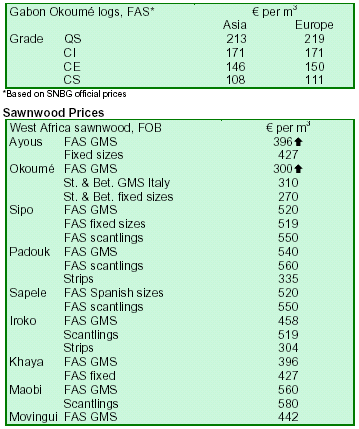
2. GHANA
Ghana timber exports retreat in 2006 amid tight supply
According to the Timber Industry Development Division (TIDD) of the Forestry Commission, export of wood
products fell to .170.1 million (451,610 m3) in 2006 (see table). This corresponds to 7.6% and 3.1% reductions in
value and volume, respectively, compared with 2005.
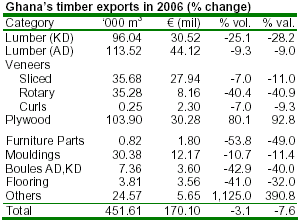
The results are short of TIDD¡¯s projections for 2006 and
buck the upward export trend of previous years (see chart). The main reason for the export decline was inadequate
wood raw materials to meet export contracts.
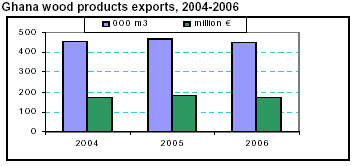
Ceiba accounted for 19.6% of the exports, followed by
wawa (19.3%), plantation teak (15.4%), African mahogany (6.3%) and asafina (3.6%). Other 82 traditional
species accounted for the remaining 35.8%.
SPWP increases share despite export reduction
Secondary processed wood products (SPWP, furniture parts, mouldings, flooring, etc.) accounted for 15% of the
total export volume and 16% of the value, up from 12% and 16% in 2005. Plywood was the only product that
recorded export increases. The main plywood species were ceiba (55% of the total plywood exports), followed by
chenchen (18%), mahogany (7%), ofram (6%) and asanfina (4%). Main plywood markets were Nigeria
(58.9%), Belgium (8.7%), Niger (7.5%), Burkina Faso
(5.8%) and Togo (4.4%), among other twenty-four countries. Despite the decline, lumber remains the main
export product, particularly kiln dried lumber. Wawa (56%) and mahogany (14%) were the main kiln-dried
lumber species. The US, Germany and UK were the main markets for the product.
Ghana and EU kick off formal VPA talks
Ghana and the EU are expected to start formal negotiations towards signing a voluntary partnership
agreement (VPA) in Brussels in February 2007. The place of the various ¡®actors¡¯ in the negotiation will be
established while the scope and key elements of the agreement will be developed and
agreed. The subsequent dates for events on the roadmap will also be reviewed and
made firm. Ghana and the EU expect negotiations to be concluded before the end of the year.
The VPA is part of EU¡¯s Forest Law Enforcement, Governance and Trade (FLEGT) initiative aimed at
establishing a trading system and a licensing mechanism to curb the sale of illegal timber
products to the EU. The agreement will also provide for cooperation, including
capacity building, market and technical studies and knowledge-sharing. The move followed a series of
informal consultations between Ghana and the EU over the past year as well as intensive consultations amongst
stakeholders in Ghana. The EU initiated similar formal VPA talks with Malaysia in
September 2006 (see TTM 11:17) and Indonesia in January 2007 (see TTM 12:1).
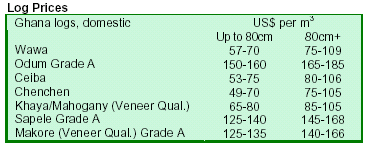
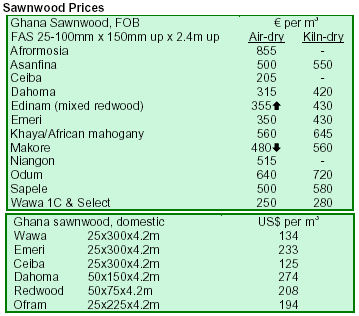
3.
MALAYSIA
Malaysian sawn industry upbeat on outlook
As the two-week long Chinese New Year celebrations come to an end, the Malaysian timber industry is gearing
up for a very promising year, particularly the sawntimber industry. On one hand, strong domestic demand for
sawntimber, mouldings and decking is seen as repair and reconstruction efforts of both private properties and public
infrastructures take place in the flood-affected states of Johor and Pahang. On the other hand, temperate countries
are beginning construction works earlier than anticipated, helped by a warmer winter.
=
Furniture makers absorb costs to remain competitive
Malaysian furniture manufacturers are facing rising costs. With the wintering period for rubber trees well underway,
prices of rubberwood remain high while supplies are persistently short. Meanwhile, a strengthening Malaysian
ringgit against the US dollar is forcing furniture manufacturers to absorb more costs without raising prices
in order to maintain a profitable customer base. Malaysia strives to remain competitive with its furniture as China
increases its share in the key US market while Vietnam continues to make inroads in this and other markets.
Plywood exporters look at opportunities in the Middle-East
Exports of Malaysian plywood and other panel products to Japan, China and India remain strong. Further market gain
is anticipated in the Middle-East, particularly in Bahrain, where both private property and public infrastructure
development is picking up pace. The latest project is the reclamation and complete upgrading of the North Manama
Dhow Harbour by the Bahrain Financial Harbour Holding Company, where marine-grade plywood will be required.
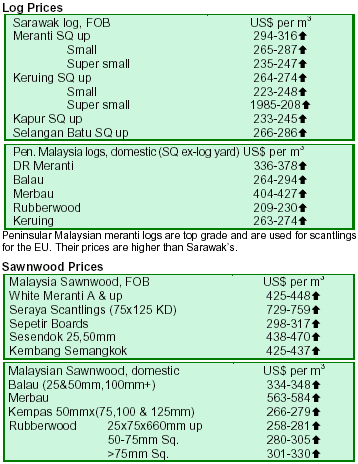
4.
INDONESIA
Prices sluggish as Jakarta prepares for rebuilding
Prices of Indonesian timber products remain largely sluggish as Jakarta struggles to find its footing. Initial
assessments of flood damage are at $1.57 billion. Assessments are still underway as more than 400,000
people, who were forced out from their homes, begin to return. Prices of staples such as rice have soared at least 25%.
Stockists of building materials are reporting massive losses as both financial records and
inventories went missing when floodwaters covered up to 60% of Jakarta at the height of the floods. Contractors of several
construction projects in and around Jakarta may file for bankruptcy as they are unable to complete the projects due
to non payment by developers, who were equally badly hit
by the floods. While there is an urgent need for rebuilding and repairment, funds are not readily available for such
works.
Timber industry pins hopes on Beijing¡¯s housing plans
Timber traders in Sumatra, Borneo and the rest of Java pin hopes on the sustained growth of the Chinese economy.
The low-cost Indonesian timber industry stands to gain from the expanding housing sector in China. The Chinese
Vice-Premier Zeng Peiyan has requested the Beijing Municipal Council to supply low-income families with
better housing. Beijing will build 10 million m2 of affordable, low-cost housing over the next three years.
Beijing will also begin to build 300,000 m2 of low-rent housing in 2007. Housing prices in some large Chinese
cities are rising quickly while small to medium residential houses are still in short supply.
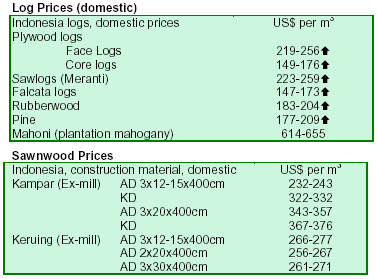
5.
MYANMAR
Teak log prices remain firm in early 2007
In late February, 1,325 hoppus tons of teak logs were sold in the tender while 1,296 hoppus tons were sold in the sealed tender.
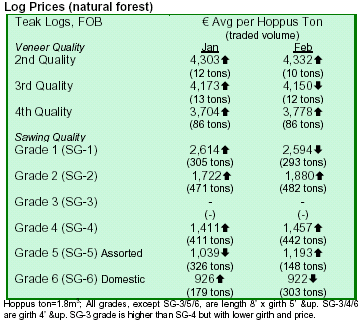
Some teak grades, including second and fourth veneer
quality as well as SG-2, SG-4 and SG-5 sawing grades, benefited from higher prices, particularly SG-2 and SG-5.
Prices for some other grades such as third veneer quality, SG-1 and SG-6 fell slightly. The teak market remains robust in early 2007.

6. PAPUA
NEW GUINEA
PNG log exports soar in 2006
Log exports from PNG rose to 270,161 m3 in December 2006, down 30% from November but up 8.6% from
December 2005 (see chart). Total log exports reached 2.64 million m3 in 2006, up 16% from 2005.

Saw/veneer grades accounted for 88% of the total log
exports in 2006. Main log export species were taun, malas, bintangor and terminalia. China took 84.5% of all log
exports, followed by Japan (7.3%), Korea (2.7%) and Vietnam (2.4%). Of the saw/veneer log grades, China
imported 89.7%, Japan 5.1%, Korea 2.1% and India 1.6%. For plantation species, kamarere remained the main export
species primarily to the markets of Japan, Vietnam, China and India.
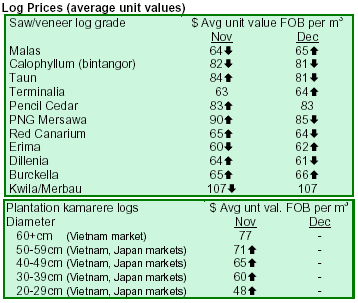
7. BRAZIL
Exports of solid-wood products rise slightly in 2006
Exports of solid-wood products rose 1.8% to $3.97 billion in 2006 helped by growing exports of added-value
products. In contrast, exports of primary wood products fell across the board. Exports of pine sawnwood exports
dropped 9.4% to $275.3 million (down 14.5% to 1.33 million m3) while those of tropical sawnwood slid 1.4% to $570.4
million (down 12.3% to 1.54 million m3). Exports of pine plywood also dropped 15% to $438 million (down 38% to
1.65 million m3) while those of tropical plywood fell more sharply (23%) to $212.5 million (down 38% to 453,800
m3). Wooden furniture exports retreated in 2006, sinking 6.7% to $813.6 million.
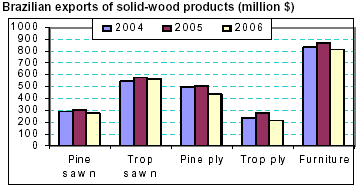
These products accounted for 58% of the export value of
solid-wood products in 2006, down from 65% in 2005. The decrease in the share of these products was largely
due to the strong appreciation of the Brazilian currency against the US dollar during 2006 that reduced the
competitiveness of the Brazilian products in international markets. Moreover, other solid-wood products (some
value-added products such as moulding and wood flooring) as well as reconstituted-wood panels increased
their export value in 2006, offsetting the reduction in exports of sawnwood, plywood and wooden furniture.
Brazilian solid-wood products exports in perspective
Over the past several years, Brazilian exports of solid-wood products grew fuelled by the huge
consumption in the US civil construction industry. From 2001 to 2004, Brazilian exports of these products grew at
an average of 20% a year. However, in the last two years, the export volume of solid-wood products to the USA has
declined significantly amid the continued strengthening of
the Brazilian real, increasing cost of wood raw materials (large-diameter logs) and growing taxes on Brazilian
plywood. In 2005, import orders from the USA fell drastically which has led to adjustments in production capacity in Brazil.
Currently, some tariff barriers contribute to limit the participation of some Brazilian solid-wood products in
international markets. In addition to the 8% US duty on Brazil pine plywood, Mexico also imposed a import duty
of 23.5% on the product. The duty has out priced the Brazilian plywood from the Mexican market. Technical
barriers, such as CE marking and other construction standards, have hindered exports to European markets.
According to some Brazilian analysts, although many Brazilian companies have abided by such requirements,
some European countries have not properly applied the norms and continued importing from companies that do
not meet the standards, mainly from China and Russia.
Brazil takes the lead in certification of tropical forests
Brazil has become the country with the largest area of FSC certified tropical forest in the world. With 5.1 million ha
of certified forests (2.8 million ha of natural forests and 2.3 million ha of forest plantations), the country ranks
sixth worldwide, behind Canada (18.9 million ha), Sweden (10.4 million ha), Russia (12.8 million ha), USA (9.3
million ha) and Poland (6.6 million ha). In Latin America, Brazil is followed by Bolivia (2 million ha) and Mexico
(0.8 million ha). In global terms, Malaysia follows Brazil with 4.73 million ha of MTCC certified tropical forests.
Manufacturers use certified wood for furniture
In Southeastern Brazil, some furniture producers have started to work exclusively with certified wood from the
Amazon. The firms are using some lesser-used species, including: louro-faia, purple wood
(roxinho), louro-cinnamon, tatajuba, tanimbuca and acapu.
Brazil to adopt ISPM 15 for wood packaging
The Secretariat of Farming Defence of the Brazilian Ministry of Agriculture has unveiled a normative
instruction (NI) that aims at adopting the guidelines and procedures to regulate phytosanitary certification of wood
packaging material and structures used in international trade. The NI adopts the ISPM 15¡¯s guidelines and
technical recommendations under the International Plant Protection Convention for regulating and certificating
wood packaging material and structures utilised in product trade internationally. The purpose of the measure is to
prevent the dissemination and introduction of plant and product diseases, as well as promoting appropriate control
measures. The measure would cover all type of wood package and structures in raw, including boxes, pallets and
wood stowage. The approval of the NI is expected in the first half of 2007.
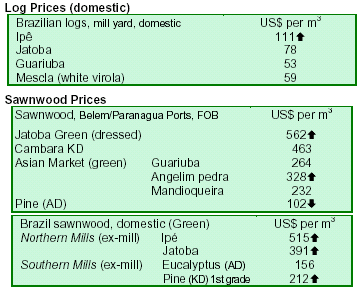
8. PERU

9. BOLIVIA

10. Guatemala

11.
Guyana
employment.
Guyana¡¯s exports of wood products surge in 2006
Guyana¡¯s exports of wood products rose to $59.54 million in 2006. The chart shows that logs (37% of the total export
value), lumber (35%) and plywood (15%) were the main export products.
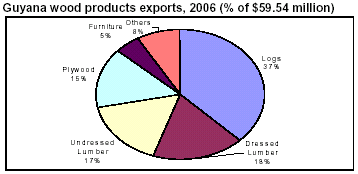
Guyana¡¯s stakeholders discuss log export policy
Guyana is in the process of defining its policy with respect to the export of logs. A public consultation session on the
issue took place on 17 February 2007 with officials and other stakeholders in the forestry industry. At the session,
the Forest Commissioner, James Singh, presented a background paper for discussion. He pointed out that other countries have either
severely restricted or entirely banned the export of logs. He added that from a consultative
process established through a ministerial committee, two possible options had been put forward for
discussion. Option one proposed a ban of 15 log species from 1 March 2007, while option two proposed a ban on exports from
January 2008. He explained that, overall, a ban/restriction on log exports would have a positive impact on export
revenue, the GDP of the forestry sector, value-added forest production and job creation.
Prime Minister Samuel Hinds urged collaboration, alliances and partnerships among stakeholders. He noted
that external alliances have to be sought to push exports of forestry products because Guyana had a small market. Mr.
Hinds cautioned that quarrels among stakeholders caused them to lose sight of the changes taking place in the
marketplace. He said that one challenge that stakeholders faced was cutting down production costs to be able to
compete with other countries. A dilemma faced in light of a ban/restriction of logs was whether the local downstream
processing capacity could grow fast enough to accommodate this situation. If this growth failed to
happen, it could trigger problems in the sector. Mr. Hinds urged local producers to move in the direction of
specialization and proposed the Forest Products Marketing Council (FPMC) as mediator in
problems involving the stakeholders in the forestry sector.
Agriculture Minister, Mr. Robert Persaud, voiced concerns about overseas investors being granted concessions for
value-added production but failing to meet their commitments. This had caused meetings with the senior
management of these companies to define corrective measures.
The Chairman of the Guyana Forest Commission (GFC) Board, Tarachand Balgobin, stressed that the aim of the
forestry industry was not only to increase its contribution to the GDP but also to increase employment opportunities,
production and productivity and enhance the welfare of people. He said that to heighten the efficiency of the
forestry sector, new forestry legislation and revenue
structure were imminent.
Chinese establish large-scale processing plants
Bai Shan Lin International Forest Development Inc, a new company with funding from China,
unveiled plans to invest approximately $100 million dollars over the next three years for added-value processing as well as timber
harvesting. The company aims at establishing two largescale timber processing factories in Linden and
Georgetown with a combined annual production capacity of 300,000-500,000 m3. The company is 49% owned by
BUCC, a construction company of China which has businesses in various countries of the world. The
company's Administrative Manager, Karen Canterbury, said that more than $10 million worth of logging
equipment had been brought in from China and other countries. The company has purchased a sawmill in
Linden, previously owned by Jaling Company, and is planning its expansion.
The company¡¯s main market will be China but once additional markets are garnered, forest
certification would have to be sought, added Ms. Canterbury. She said that in
order to maximise the use of the forest resources, the company will embark on a project to utilise the bark,
branches, defective wood and factory waste to make high density boards. She estimated that the company would be
able to produce 200,000 m3 of high density boards within the next three years.

|